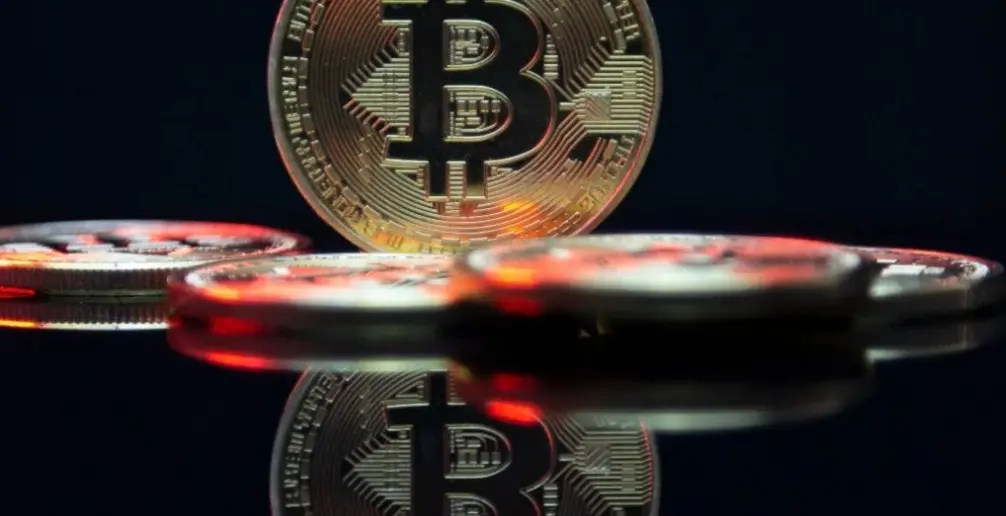Glassnode Research: ETF Dynamics are Crucial, Bitcoin Halving Impact Weakens
Author: Marcin Milosierny
Compiled by: Ladyfinger, Blockbeats
Original link:
https://insights.glassnode.com/trading-strategies-for-bitcoin-halving-2024/
Halving and ETF Supply Drain
Market participants often view Bitcoin halving as a precursor to a bull market, as it reduces the rate at which new Bitcoins are generated. Halving cuts the rewards for miners who validate transactions and create new blocks in half, effectively slowing the influx of new Bitcoins into the market.
Moreover, this preordained scarcity is expected to reduce selling pressure from miners, as they typically need to sell the Bitcoins they earn as rewards to cover operational costs. In theory, as the supply of new Bitcoins available for sale decreases, the scarcity effect kicks in, historically creating conditions for price increases as supply tightens while demand remains stable or grows.
However, current market conditions differ from historical norms. As the time for Bitcoin halving approaches, the impact of newly mined and circulated Bitcoins is becoming increasingly negligible compared to the surging demand for ETFs. As shown in the Glassnode chart below, the number of Bitcoins cleared from the market by ETFs is several times the number of Bitcoins minted daily.
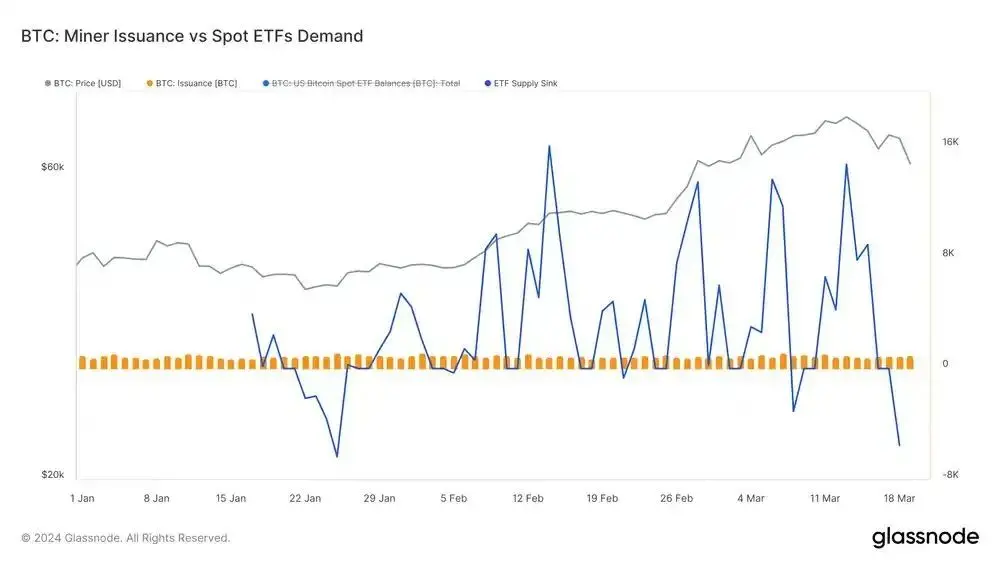
Currently, miners are supplying about 900 Bitcoins to the market each day. After halving, this number is expected to drop to around 450 Bitcoins, which, under past market conditions, could have exacerbated Bitcoin's scarcity and driven prices up. However, the large-scale acquisition of Bitcoins extracted from circulation by ETFs far exceeds the daily output of miners, indicating that the upcoming halving may not lead to the anticipated supply tightening.
Essentially, ETFs have preemptively reduced the available supply through substantial and sustained purchasing activity, thereby preemptively influencing the effects of halving. In other words, the supply tightening typically expected from halving may occur due to the large-scale Bitcoin acquisitions by ETFs. These funds currently exert significant influence over the availability of Bitcoin, which may obscure the impact of halving on the market in the medium to short term.
However, ETF activity introduces its own complexities to market dynamics. For instance, the impact of ETFs on Bitcoin prices should not be one-sided. Despite the current trend of substantial capital inflows, the possibility of outflows still exists, posing a risk of sudden market shifts. Closely monitoring ETF activities, including purchases and potential sales, is crucial for predicting market movements as halving approaches.
Impact of Long-Term Holder Supply
As ETF activity may weaken the impact of halving on Bitcoin's long-term price dynamics, other key market factors will come into focus. In terms of supply dynamics, aside from the contribution from miners, a major source of supply comes from long-term holders (LTH). Their decisions to sell or hold have a significant impact on market supply and demand.
In the Bitcoin ecosystem, market participants are often categorized as long-term holders (LTH) or short-term holders (STH) based on how long they have held their Bitcoins. LTH are defined by Glassnode as entities that have held Bitcoin for a long time (typically over 155 days). This classification is based on the observation that Bitcoins held beyond this period are less likely to be sold in the face of market volatility, indicating a stronger belief in Bitcoin's long-term value. In contrast, STH are more sensitive to price changes, often causing immediate supply and demand fluctuations.
To illustrate the role of LTH in Bitcoin market supply dynamics, Glassnode analysts have proposed the Long-Term Holder Market Inflation Rate metric. It shows the annualized rate at which long-term holders accumulate or distribute Bitcoins relative to the daily issuance by miners. This rate helps identify net accumulation periods (when long-term holders effectively remove Bitcoins from the market) and net distribution periods (when long-term holders increase selling pressure in the market).
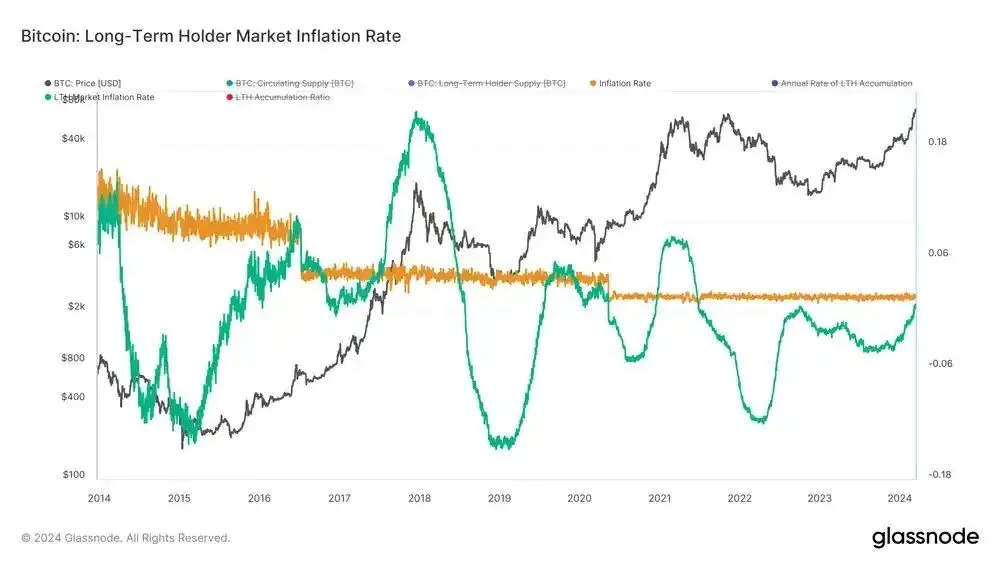
Historical patterns indicate that as the peak distribution of LTH approaches, the market may tend to balance and potentially reach a peak. Currently, the trend of the LTH market inflation rate indicates that we are in the early stages of a distribution cycle, having completed about 30%. This suggests that there will still be significant activity in the current cycle before reaching a market equilibrium point and potential price peak from a supply-demand perspective.
Given this, traders should closely monitor the long-term holder market inflation rate, as this metric can guide trading strategies, particularly in identifying potential market tops or bottoms on a macro scale.
Is Halving a Sell-the-News Event?
Although halving is typically interpreted as a bullish signal for Bitcoin, its direct impact on the market is largely influenced by psychological factors. Sometimes, the market views it as a "sell-the-news" event, where market sentiment and prices build momentum before halving, only to lead to significant price adjustments shortly after.
For example, in 2016, the market experienced a sharp sell-off from around $760 to $540 around the halving period, a decline of 30%. This drop is a typical example of market participants reacting to the event itself rather than the long-term supply impact, demonstrating that halving can trigger immediate market volatility.
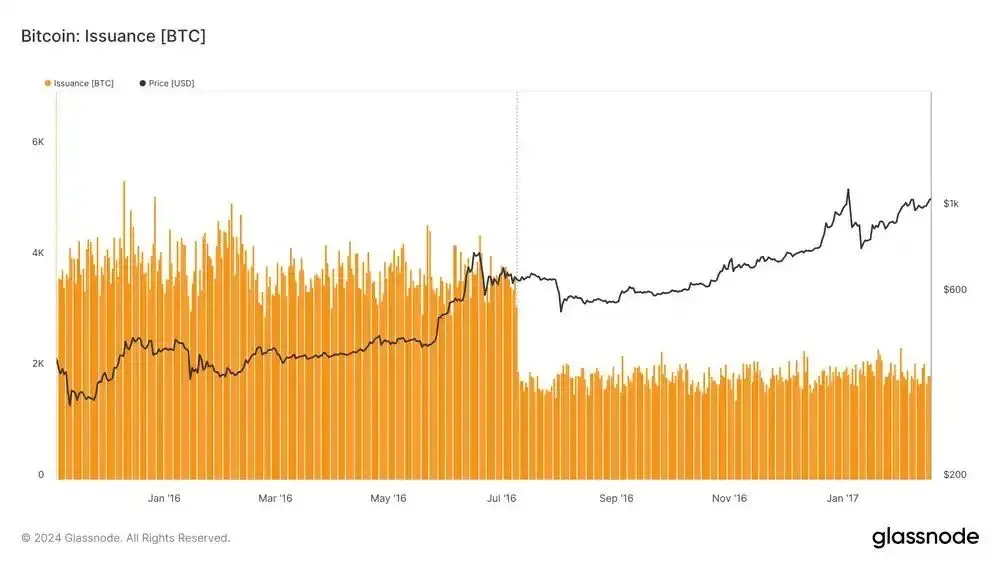
The 2020 halving presented a more complex scenario. Although the direct consequences did not reflect the sharp sell-off seen in 2016, the price recovery before halving, followed by a reduction in issuance, subjected miners to a "double whammy," exacerbating their challenges. This period did not experience the traditional "sell-the-news" event but highlighted the nuanced market reactions to halving events, influenced by broader economic conditions and market sentiment.
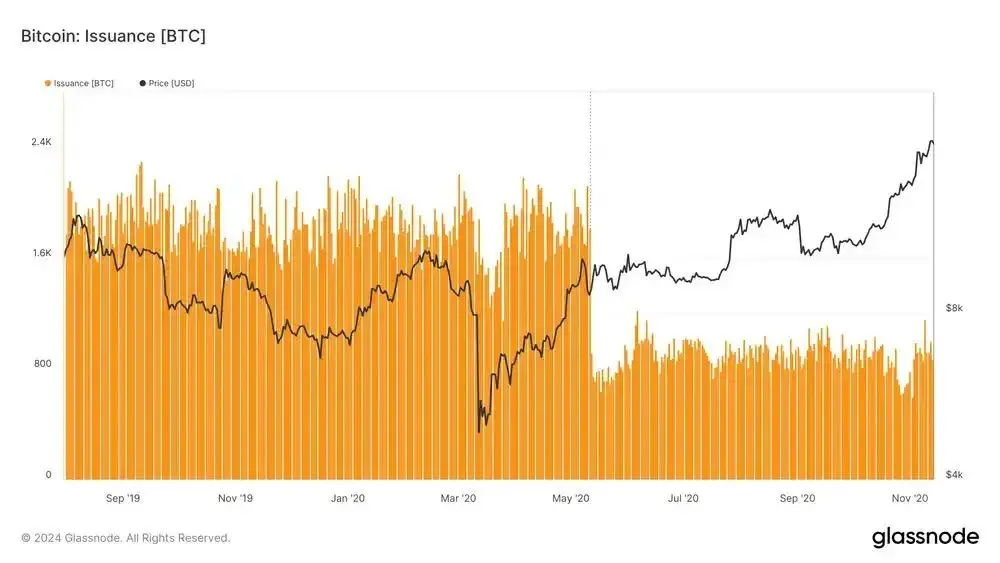
As we approach the next Bitcoin halving, the market structure seems to indicate a potential significant adjustment. Such an adjustment would not only align with historical patterns but also serve to reset the market, eliminate short-term speculative behavior, and lay the groundwork for the next growth phase.
This expectation hinges on several factors, including the ongoing impact of ETFs on the market. While their purchasing activity provides substantial support for Bitcoin prices, it is widely believed that these inflows cannot continue indefinitely. If ETF inflows begin to slow or reverse before halving, we may witness a compounded effect on the market. Expectations of reduced ETF demand, combined with traditional halving psychology, could trigger a period of high volatility, prompting traders to adjust their positions based on early signs of change.
In summary, the direct impact of halving on the market will be influenced by psychological factors and institutional participation dynamics. Traders should prepare for potential volatility during the halving period, using ETF activity as a key indicator of short-term market sentiment.
Differences in This Cycle
Historically, Bitcoin cycles typically start 12 to 18 months after the previous bull market peak, with new all-time highs (ATH) occurring a few months after halving. This has led many to suggest that the halving event itself catalyzes the next bull market due to the supply constraints it introduces.
However, due to the new institutional demand introduced by Bitcoin ETFs, the effects of halving in this cycle may be diminished. This demand and the capital inflow brought by ETFs into the Bitcoin network may have already led BTC to break the previous cycle's ATH before halving.
However, this fact has led some to speculate that the current cycle may be shorter than previous ones. While it is uncertain whether this will occur, data can be examined to assess which stage of the market cycle we are currently in and the likelihood of the bull market continuing.
First, from a cyclical pattern perspective, breaking the ATH before halving does not necessarily mean deviating from Bitcoin's historical norms. The key is to assess when the peak of the previous cycle's bull market actually occurred. In Glassnode's analysis, it has long been believed that this happened in April 2021, even though Bitcoin's price was higher in November 2021 from a technical standpoint. This assumption is based on the fact that after the April peak, most technical and on-chain indicators related to market sentiment and investor behavior began to exhibit their typical bear market values and never truly recovered.
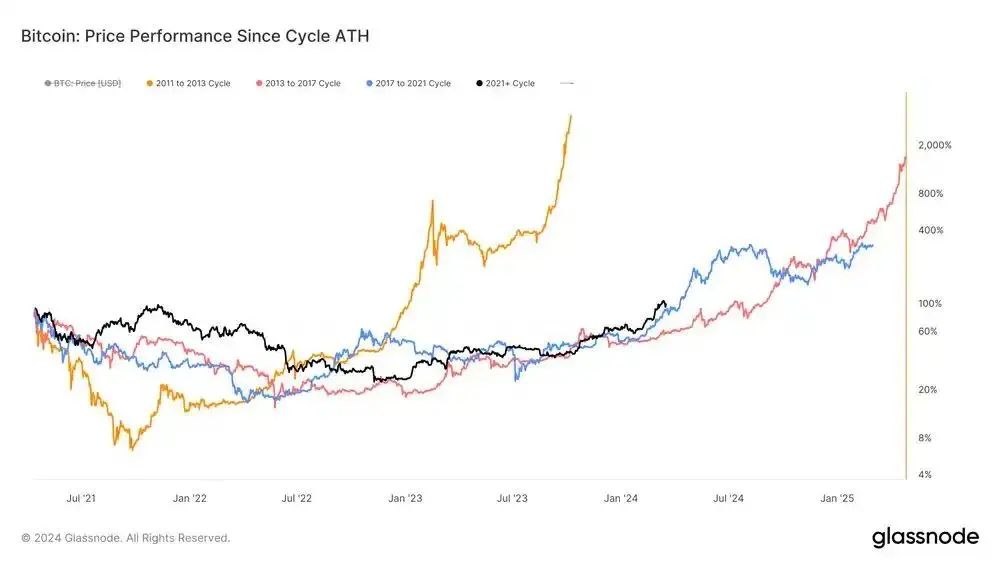
Now, using April 2021 as the peak of the previous bull market, it can be seen that the current cycle aligns well with historical norms. This suggests that despite breaking the previous ATH before halving, the bull market may still continue for a longer duration.
In evaluating the differences between the current cycle and historical norms and trends, and considering the perspective of enhancing trading strategies, monitoring the "bull market correction drawdown" metric may also be practical. This metric reflects the depth and frequency of price drawdowns during a sustained bull market.
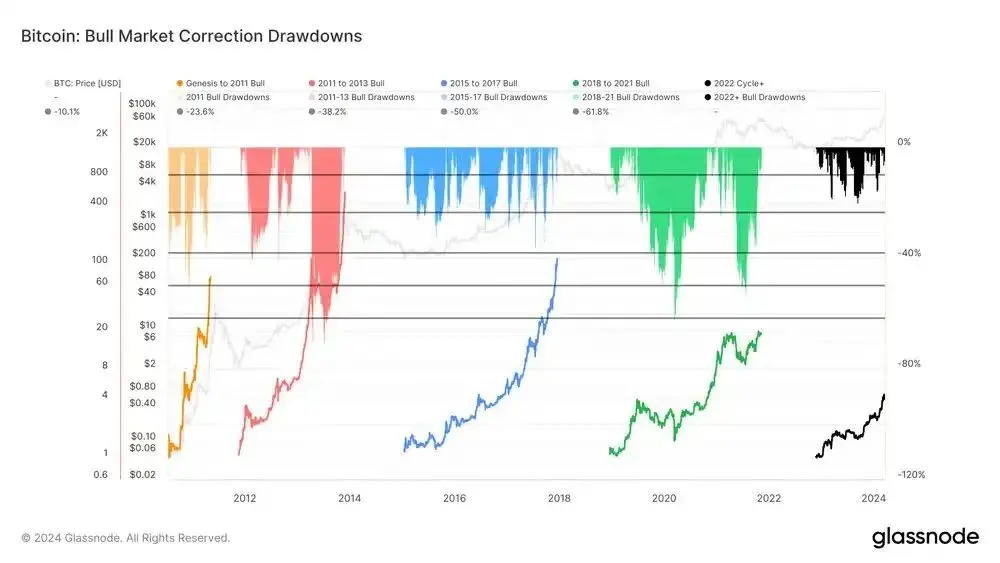
Notably, this cycle has exhibited less severe drawdowns compared to the typical 30-40% declines seen in past bull markets. Tracking these drawdowns can provide traders with indicators of market sentiment, risk appetite, and potential turning points. As ETF inflows continue to impact the market, significant changes in this trend of milder drawdowns may signal a shift in investor behavior and provide timely clues for strategy adjustments.
Impact on Directional Trading Strategies
Even as we approach the halving event, the role of ETFs in shaping the Bitcoin market landscape cannot be overlooked. However, it is equally critical to focus on the impact of long-term holders (LTH) on market supply dynamics. The interplay between the supply squeeze from halving and the fluctuations in ETF demand introduces a complex dynamic that could significantly alter the traditional market response to halving events.
For traders looking to refine their directional strategies, monitoring LTH behavior becomes essential. Whether LTH decide to hold their positions or begin distributing their holdings can provide early indicators of shifts in market sentiment and potential liquidity changes. Given the current market conditions, where ETFs have already influenced the supply-demand balance, significant actions by LTH could become critical points defining market direction post-halving.
Therefore, successful directional trading in this cycle is likely to depend on a multifaceted approach. Traders need to closely monitor ETF activity for signs of sustained demand or emerging selling pressure. Simultaneously, they must assess the sentiment and actions of LTH, whose decisions to sell or hold can further influence market supply dynamics. Adapting trading strategies to these influences is crucial for effectively navigating the next phase of the Bitcoin market cycle.



